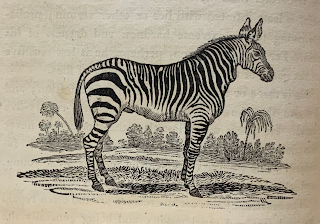 What is wood engraving exactly? It's a method of illustration printed from blocks of wood where the image has been carved into the end grain. Unlike other wood cuts, which are made by carving along the grain, the benefit of engraving is its hardness and durability. An engraved wood block could be used to print images in far more detail and would deteriorate far more slowly, even when applied in a printing press alongside metal type.
What is wood engraving exactly? It's a method of illustration printed from blocks of wood where the image has been carved into the end grain. Unlike other wood cuts, which are made by carving along the grain, the benefit of engraving is its hardness and durability. An engraved wood block could be used to print images in far more detail and would deteriorate far more slowly, even when applied in a printing press alongside metal type.It wasn't until the 18th century that this technique was really embraced for illustration. It had previously been utilized to a degree but, to quote one account, "it can scarcely be said to have existed, except in its ruder forms. Tasteless emblematical ornaments and tail-pieces, diagrams and rough designs for magazines, illustrations of an elementary character for a few books." An English artist named Thomas Bewick (1753-1828) was responsible for the turnabout. Deeply in love with nature and with making art, a fourteen-year-old Bewick was apprenticed to the engraver Ralph Beilby, whose business was making such miscellanies as described above. He excelled at the work and, among the rest, began to take on commissions for children's books. With his own practice, he continued to develop his technique and eventually began writing his own books and illustrating them with wood engravings with a "singular technical dexterity."
 Today's item is an 1807 edition of A General History of Quadrupeds, Bewick's first original text. A natural history book aimed at children, the General History is both informative and humorous. One description states that the porcupine, though "denied the privilege of making offensive war, it is sufficiently armed to resist the attacks of animals much more powerful than itself." Meanwhile, the zebra is "one of the most beautiful, and also one of the wildest and most untameable animals in nature... its liberty has heretofore remained uncontrouled." The book was massively successful with its intended audience, as well as with adult readers.
Today's item is an 1807 edition of A General History of Quadrupeds, Bewick's first original text. A natural history book aimed at children, the General History is both informative and humorous. One description states that the porcupine, though "denied the privilege of making offensive war, it is sufficiently armed to resist the attacks of animals much more powerful than itself." Meanwhile, the zebra is "one of the most beautiful, and also one of the wildest and most untameable animals in nature... its liberty has heretofore remained uncontrouled." The book was massively successful with its intended audience, as well as with adult readers.To see a charming book that helped kicked off wood engraving as a serious art form, ask for A General History of Quadrupeds, Illus B468be.